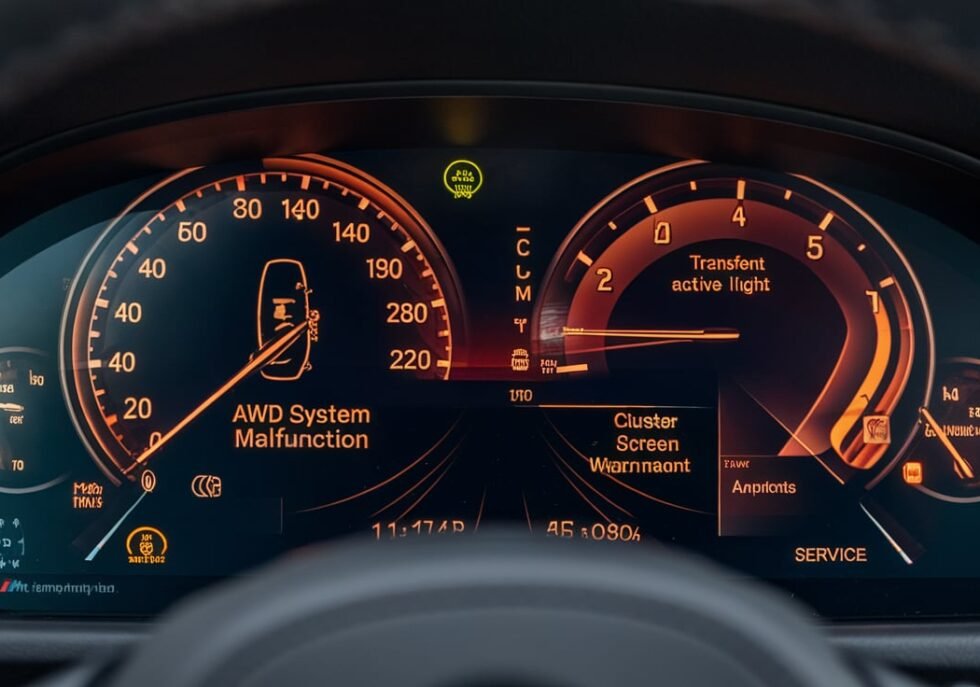
BMW Service Indicator System | Trust It or Double-Check?
Should You Trust the BMW Service Indicator System? One dashboard light. One beep. And suddenly, you are questioning your engine’s health. The BMW Service Indicator System is designed to keep you one step ahead, but can you rely on it in Dubai’s brutal traffic, dust, and heat? This is not just about flashing symbols. It is about whether trusting them keeps your BMW running strong, or leaves you stranded.
This page is going to break it down. No fluff. No vague tips. Just what you need to know, especially if you live in Dubai where the heat, sand, and stop-and-go traffic push your German engine harder than usual. So, let us dig into the reality of this system, how it works, where it fails, and what you should do when it fails at the worst time.
What Is the BMW Service Indicator System?
Let us be honest, most people ignore that tiny wrench icon until something goes wrong. But what if your BMW is already warning you, quietly? The BMW Service Indicator System is more than just a reminder. It is part of BMW’s Condition Based Service (CBS), a smart network of onboard diagnostics and sensors that track real-time wear, not just miles. Instead of guessing based on a set interval, the system monitors your engine oil, brake pad thickness, coolant level, and microfilter condition using actual data. This is displayed on your iDrive system or instrument cluster in the form of service alerts.
Let us say your brake pads are getting low. You will see it before you feel it. That is the system doing its job, ideally. But here is the catch: Dubai’s aggressive climate and stop-start driving can sometimes wear things out faster than CBS predicts. And that is where confusion starts. The BMW Service Indicator System is helpful. But only if you understand how it thinks.
How It Works | Behind the Alerts?
Ever wonder how your BMW knows when to call for help? The BMW Service Indicator System is not guessing, it is watching. Beneath that smooth iDrive interface is a network of sensors collecting constant sensor data. Oil temperature, brake pad thickness, air quality, engine load, it is all tracked, processed, and interpreted by the car’s onboard algorithm.
This is not your average timer-based system. It is usage-based maintenance. That means the alerts adapt based on your real-world driving habits, not just mileage. Drive fast? Take short trips? Crawl through Dubai’s endless traffic jams? The system notices. And it adjusts. Here is what happens:
- Sensors detect wear and usage patterns.
- Data is sent to the central CBS computer.
- The algorithm processes it and calculates remaining service life.
- Your iDrive screen displays a color-coded alert: green (good), yellow (due soon), or red (urgent).
- If needed, error codes are generated and stored, ready for a technician to diagnose.
It sounds smart. And it usually is. But even a system this advanced can be off, especially in unpredictable climates like Dubai. If you’ve ever faced unexpected warnings or false alerts, our BMW malfunction guide explains how system misreads can lead to sudden drivetrain or sensor errors and what real diagnostics reveal. So while the BMW Service Indicator System is powerful, it is not perfect. And knowing what it is doing behind the scenes? That gives you control, not just a blinking light.

BMW Adaptive LED Indicators | Precision Signaling Meets Intelligent Design
BMW’s Adaptive LED Indicators aren’t just about blinking lights; they’re engineered communication tools that sync with your driving intent, vehicle systems, and environmental conditions. In Dubai’s fast-paced, multi-lane traffic, they’re not a luxury; they’re a necessity.
What Makes Them “Adaptive”?
Unlike traditional indicators, BMW’s Adaptive LEDs are integrated with:
- Dynamic Turn Signals: Sequential lighting that flows in the direction of the turn, improving visibility and reaction time for other drivers.
- Cornering Intelligence: Indicators work in tandem with adaptive headlights, illuminating curves and junctions as you steer.
- Lane Change Assist: When paired with radar and camera systems, the indicators activate contextually, based on speed, blind spot detection, and steering input.
Technical Integration
- FRM Module Control: The Footwell Module governs indicator behavior, including brightness, timing, and fault detection. A failing FRM can cause ghost blinking, hyperflash, or total indicator loss.
- CAN Bus Communication: Every blink is a signal across the car’s digital nervous system. Faults here can cascade into ABS, traction control, or even iDrive alerts.
- LED Lifespan & Heat Resistance: BMW’s LEDs are rated for high thermal loads, critical in Dubai’s 45°C summers, where cheaper aftermarket units often fail prematurely.
Why It Matters in Dubai?
- High-Speed Lane Discipline: On Sheikh Zayed Road, a delayed or dim indicator can mean the difference between a smooth merge and a near miss.
- Luxury Expectations: BMW drivers expect flawless signaling, not flickering bulbs or mismatched aftermarket kits.
- Legal Compliance: UAE traffic laws require fully functional indicators. Malfunctions can lead to fines or failed inspections.
Common Issues We Fix at BMW Garage Dubai
- FRM module replacement and coding
- CAN bus diagnostics for intermittent faults
- LED unit replacement with OEM parts
- ISTA/D scans to trace indicator logic errors
✅ Pro Tip
If your BMW’s indicators blink too fast, stay dim, or trigger dashboard errors, don’t ignore them. It’s rarely “just a bulb.” It could be a deeper electrical issue that compromises your entire lighting system.
CAN Bus Communication in BMWs | The Digital Nervous System Behind Every Blink
Modern BMWs don’t just blink when you hit the indicator stalk; they negotiate. Every signal, light, and module is part of a high-speed conversation happening over the Controller Area Network (CAN Bus). Think of it as the digital bloodstream of your car, where even a faulty indicator can ripple across systems.
What Is CAN Bus?
- A multi-channel communication protocol that lets ECUs (Electronic Control Units) talk to each other in real time.
- In BMWs, it connects everything from the FRM (Footwell Module) to the ABS, iDrive, adaptive headlights, and even climate control.
- It’s faster, lighter, and more fault-tolerant than traditional wiring, critical for luxury vehicles packed with tech.
Why It Matters for Indicator Faults
- A failed indicator isn’t always a bulb; it could be a CAN signal dropout, a corrupted message from the FRM, or a voltage spike from a failing relay.
- CAN faults can trigger false dashboard warnings, disable adaptive lighting, or even affect lane assist and blind spot monitoring.
- In Dubai’s heat, thermal stress on wiring and connectors can cause intermittent CAN failures, especially in older 5 and 7 Series models.
How BMW Garage Dubai Diagnoses CAN Issues
- ISTA/D and INPA scans to trace signal paths and module responses.
- Live data monitoring to catch intermittent faults that don’t trigger hard codes.
- Pin-by-pin voltage testing on FRM and JBE connectors.
- OEM module replacement and coding to restore full CAN integrity.
Real-World Example
A 2016 BMW 528i came in with a fast-blinking left indicator and no fault codes. Our scan revealed a CAN dropout between the FRM and the JBE (Junction Box Electronics). The fix? Replacing a corroded connector buried under the driver’s footwell, restoring not just the indicator, but also the ambient lighting and auto-fold mirrors.
Types of Alerts | What They Mean?
You are cruising down Sheikh Zayed Road, and boom, that service light shows up. Again. The BMW Service Indicator System does not just flash lights for fun. Every icon, every color shift, every beep, it is trying to say something. But let us be real, most drivers just stare at the dashboard wondering, “Is this urgent or can it wait?” Here is a simple breakdown of what the most common alerts mean:
- Yellow Warning | A reminder. Something like an oil service indicator is due soon. You have time, but do not ignore it for too long.
- Red Warning | Immediate action. This could be a brake pad alert or something more serious. Driving further could cause damage.
- Service Due Icon | Shows a car on a lift. This means a general inspection or minor service is needed.
- Engine Oil Symbol | You will see a small oil can. Either top-up or a complete change depending on usage.
- Brake Symbol | Usually a circle with dashes. This is your brake pad or fluid, both critical in Dubai traffic.
The BMW Service Indicator System is not trying to scare you. But if you treat these symbols like optional popups, it can cost you later. Understanding them? That is your first step to avoiding real trouble.
Accuracy & Reliability | Dubai Conditions Are Different
Let us be honest, Dubai’s climate is brutal. Your BMW may be German-built, but it was not born in the desert. Now, the BMW Service Indicator System is built to adapt. It learns your driving patterns. It reacts to data. But what happens when that data is pushed to the extreme? Extreme desert heat, constant stop-start traffic, and high levels of dust can confuse the system. Sensors might react earlier, or worse, not soon enough. For example, issues like rising coolant temperature or fan failure don’t always trigger warnings fast enough, check our BMW overheating warning signs in UAE cars to spot early engine stress before the system even notices.
For example:
- Oil sensors might underestimate breakdown speed in high heat.
- Brake pad wear happens faster when crawling across hot asphalt, especially in Marina or Deira traffic.
- Dust buildup can trigger false positives, especially with microfilters and air sensors.
You might see a service light for oil even though you just changed it. Or get no alert at all when your brakes are nearly gone. That is why relying only on the BMW Service Indicator System in Dubai. Risky. As The Mechanic Autos puts it, routine service in Dubai should be more frequent than the system suggests. You can trust the system, but in Dubai, you better double-check.
Pros | Why the BMW Service Indicator System Helps
Some drivers overdo it. Others wait until it is too late. But the BMW Service Indicator System? It helps you strike the balance. By monitoring real wear instead of guessing, the system pushes you toward proactive maintenance. That means fewer surprises, and fewer wallet-burning breakdowns. Here is what you gain when you use it right:
- Tailored service | The system reacts to your driving patterns, not a generic mileage chart.
- Cost-effective planning | No more wasting money on services you do not need.
- Genuine parts used only when needed | No premature replacements, just timely ones.
- Avoids over-servicing | Dubai workshops often recommend more than necessary. The system keeps it honest.
- Better warranty adherence | BMW service history stays clean and accurate.
In short, the BMW Service Indicator System is not just tech fluff. It is a real-time assistant that helps you stay one step ahead, if you know how to read it.
Limitations | When the System Is Not Enough
Let us not sugarcoat it. The BMW Service Indicator System has limits. Sure, it is smart. But it is still a machine. It cannot feel a shaky brake pedal. It cannot smell burnt oil. And sometimes, it does not warn you in time. We have seen cases where:
- A sensor failed silently. No alert. The coolant was dangerously low.
- The system was reset by mistake after an oil change, but the oil itself was not even replaced.
- A customer trusted the system and skipped a service. The spark plugs were way overdue.
These are not rare glitches. They are system limitations. This is where manual checks and physical inspections come in. Your BMW might not blink a warning, but that does not mean everything is fine. Especially in Dubai, where heat and sand accelerate wear.
And what about older BMWs? Some of them rely heavily on mileage-based service, not usage data. In that case, a mix of manual logic and sensor readings becomes essential. So yes, use the BMW Service Indicator System. But never trust it blindly.

System-Only vs. Expert Review | What Keeps You Safer?
The BMW Service Indicator System is helpful — no doubt. But is it enough on its own? Relying on one source of truth in a city like Dubai? That is a risk. Especially when a professional audit can catch what a sensor might miss. Here is how both approaches stack up:
| Approach | What It Covers | What It Misses |
|---|---|---|
| System Only | Sensor-based alerts, oil/brakes | Sensor faults, hidden wear |
| Expert Check Only | Manual inspection, road feel, leaks | No digital error codes or service logs |
| Combined Workflow | Both digital + physical review | Full coverage, no guesswork |
When we do a service indicator check, we do not just read a code. We listen, inspect, and verify. It is a dual-layer monitoring system that protects your investment. Visit our BMW Garage Dubai service center to book a full diagnostic check for same-day service, trusted parts, and detailed reports built for UAE driving conditions. One client came in for a light reset. We caught a torn bushing that could have damaged the suspension within days. The BMW Service Indicator System works best when paired with trained eyes and hands, not just tech. That is where peace of mind comes from.
Do Not Rely Blindly – Drive Smarter
The BMW Service Indicator System is a brilliant tool, but not a replacement for expert eyes. In Dubai, where conditions hit harder, trusting that system alone can backfire. You need more than a blinking light. You need context, judgment, and a garage that understands what those alerts mean. That is where we come in.
If you are seeing a warning, or even if you are not, do not wait. Book a visit with our Dubai BMW garage, and let us run a full trusted diagnostic check alongside the system. We combine digital precision with real-world inspection, so nothing gets missed.
Ready for actual peace of mind? Click here to schedule your appointment or speak to a technician directly. Your BMW deserves both logic and care, not blind faith in electronics.




